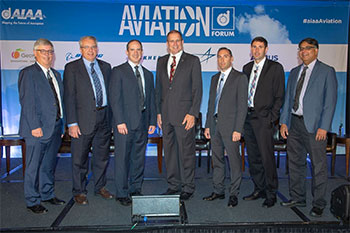NASA’s New Aviation Era Written 29 June 2018
Panelists: Moderator Rich Wahls, strategic technical adviser, Advanced Air Vehicles Program, NASA’s Langley Research Center; Robert Pearce, deputy associate administrator for strategy and acting director for Airspace Operations and Safety Program, NASA Headquarters; Peter Coen, project manager, Commercial Supersonic Technology Project, NASA; Jay Dryer, director, Advanced Air Vehicles Program; Davis Hackenberg, strategy adviser for urban air mobility, NASA’s Aeronautics Research Mission Directorate; Parimal Kopardekar, senior technologist for air transportation systems, NASA’s Ames Research Center; Craig Nickol, manager, Low Boom Flight Demonstrator Project, Integrated Aviation Systems Program, NASA
by Tom Risen, Aerospace America Staff Reporter (2017-2018)

During the “NASA Aeronautics at the Dawn of a New Era of Aviation” panel discussion June 28 at the 2018 AIAA AVIATION Forum in Atlanta, NASA officials explained how the agency is creating technologies to help companies design new types of aircraft that meet the shifting demands of the public while observing safety and acceptable noise standards.
Robert Pearce, acting director for NASA’s Airspace Operations and Safety Program, said Congress and the general public are excited about the agency’s aeronautics projects but that planning for experimental planes is difficult because funding is often granted one year at a time.
“We need to make sure we have a five-year budget” to develop X-planes, Pearce said.
NASA has contracted Lockheed Martin’s Skunk Works to build a piloted X-plane that will test technologies for reducing the noise of a sonic boom enough to permit supersonic flights across the U.S. On June 26, the U.S. Air Force designated the plane the X-59 QueSST, naming it for the Quiet Supersonic Technology plane design Lockheed Martin created for NASA in 2016.
Peter Coen, project manager for NASA’s Commercial Supersonic Technology Project said the ban put in place against supersonic flight over land in the U.S. has been warranted but that the international challenge is now “how do we define acceptability” for noise created by planes that make a sonic thump instead of "unacceptable" sonic boom.
Jay Dryer, director of NASA’s Advanced Air Vehicles Program said the agency is being selective in research it can do to enable certification, safety and public acceptance for new types of aircraft but added it will also help prove out adjustments to subsonic airplanes.
Dyer said NASA recognizes the need for research “isn’t binary” between traditional markets or the new markets: “It’s really both,” he said.
NASA has completed market studies recently about the interest in electric vertical takeoff and landing aircraft that companies are designing and testing with the aim of ferrying people from a city to the suburb, said Davis Hackenberg, strategy adviser for urban air mobility at NASA’s Aeronautics Research Mission Directorate.
“I would bet it’s hundreds of billions of dollars going into this industry over the next few years right now,” Hackenberg said of funding eVTOLs for urban air mobility. “There is a real opportunity to make this happen.”
